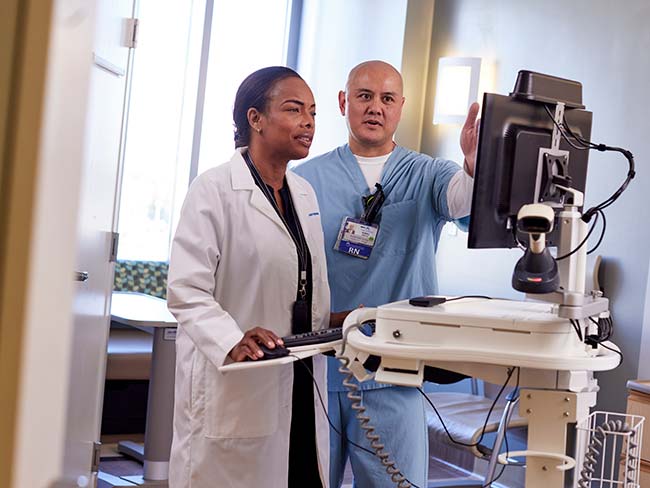Permanente embraces its partnership with labor
Henry J. Kaiser's legacy of labor relations continued after World War II through their support for the new health plan, creating lasting partnership opportunities.
Henry J. Kaiser and Sidney R. Garfield, MD, survey the site for the Walnut Creek Medical Center, completed in 1953
Throughout its history, Kaiser Permanente has relied on the “can-do spirit” of its dedicated workers and on the support of organized labor to keep the prepaid health plan strong.
Coming out of World War II, the medical plan had proven its viability in caring for a large shipyard workforce, but with the end of shipbuilding contracts, Henry Kaiser and Permanente founder and medical director Dr. Sidney Garfield had a big problem. Where were the large numbers of new members going to come from?
Kaiser, a friend of labor, attracted workers’ unions whose leaders understood the power of prepaid health care and wanted it for the welfare of their workers. Bay Area workers — from Oakland city employees, who were the first to sign up, to union typographers, street car drivers and carpenters — embraced the Permanente Health Plan with its emphasis on preventive medicine.
In 1950, Harry Bridges brought the 6,000-member International Longshoremen and Warehousemen Union (ILWU) into Kaiser Permanente, bringing the total West Coast membership, including Los Angeles, to almost 160,000. In 1951, the Retail Clerks union added 30,000 to the membership rolls in Los Angeles.
Opposition tries to squelch Kaiser Permanente
Despite this success, Kaiser and Garfield often faced rear guard actions from private practice doctors who felt threatened by group practice medicine. In 1953 when KP opened a new hospital in Walnut Creek and sought the health plan contract with workers in the U.S. Steel plant in Pittsburg, California, all hell broke loose in that small town along the Carquinez Strait.
Before Kaiser Permanente came along, the steelworkers union had both a national hospitalization plan and a local supplementary health plan with local private practice doctors. The workers were not satisfied with the current health plan and were complaining that providers charged too much and were lackadaisical about responding to emergencies and requests for house calls.
For their part, the Pittsburg area doctors argued that inflation required rates to rise and disputed the idea that service to members was lax.
Kaiser Permanente already provided care to steelworkers at the South San Francisco Bethlehem Steel plant and was prepared to expand services to the Pittsburg area. The beginning of KP’s negotiations with the Steelworkers Local 1440 in Pittsburg raised the hackles of the 41 private practice doctors already established in the area.
These doctors, all members of the East Contra Costa branch of the Alameda-Contra Costa Medical Association, quickly devised a new and better plan to offer the union, including 24-hour emergency service and a cap on fees.
Offer steelworkers couldn’t refuse
Joseph Garbarino, in his 1960 study of the Pittsburg conflict for the University of California, reported that the union bargainers welcomed Kaiser Permanente because of its offer to provide comprehensive care for a specific price for a specified period of time. This arrangement was attractive to the local union whose leadership had never before been able to negotiate such a favorable deal with their private practice providers.
-
Social Share
- Share Permanente Embraces Its Partnership With Labor on Pinterest
- Share Permanente Embraces Its Partnership With Labor on LinkedIn
- Share Permanente Embraces Its Partnership With Labor on Twitter
- Share Permanente Embraces Its Partnership With Labor on Facebook
- Print Permanente Embraces Its Partnership With Labor
- Email Permanente Embraces Its Partnership With Labor

May 8, 2025
National Alliance bargaining begins
Kaiser Permanente and the Alliance of Health Care Unions kick off negotiations …
May 8, 2025
National Union of Healthcare Workers ratifies agreement
Kaiser Permanente Southern California and NUHW will enter into a new 4-year …
May 8, 2025
New NUHW contract ratified
Kaiser Permanente Southern California and the National Union of Healthcare …
May 4, 2025
Tentative agreement reached
NUHW ends strike in Southern California and will conduct ratification vote …

May 2, 2025
Working together at the heart of health care
Organized labor is key to who we are, where we’ve been, and where we’re …

April 30, 2025
A history of trailblazing nurses
Nursing pioneers lay the foundation for the future of Kaiser Permanente …
April 24, 2025
Contract negotiations continue
Kaiser Permanente and NUHW met on April 22 and 23. Talks are set to continue …
April 22, 2025
The facts in our NUHW negotiations: April 22
Despite what the leaders of NUHW claim, the union is demanding more pay …
April 16, 2025
Kaiser Permanente and NUHW restart contract negotiations
Discussions resume April 22.

April 16, 2025
Sidney R. Garfield, MD: Pioneer of modern health care
Kaiser Permanente’s co-founding physician spread prepaid care and the idea …
April 11, 2025
The focus returns to bargaining
As NUHW ends its hunger strike, Kaiser Permanente remains focused on negotiation …
April 7, 2025
The facts: NUHW negotiations
Despite what NUHW's leadership claims, they are demanding more pay to care …
April 7, 2025
The facts in our NUHW negotiations
We find it deeply concerning that NUHW leadership would place the health …
March 29, 2025
We are meeting mental health care access requirements
The investments we’ve made over the last several years have resulted in significant improvements ...
March 12, 2025
NUHW walks away from mediation process
We will continue our focus on providing timely access to the high-quality, …
February 14, 2025
Kaiser Permanente updates key offer in latest proposal
The new offer increases protected time.
February 10, 2025
Kaiser Permanente and NUHW continue talks
No additional tentative agreements reached. Both sides presented counterproposal …
January 31, 2025
Details of our current offer to NUHW in Southern California
You deserve a contract that rewards you for the excellent care you provide …
January 31, 2025
New tentative agreement reached
Kaiser Permanente and NUHW take another step toward a new contract.
January 30, 2025
We are focused on providing high-quality care, as always
We look forward to continued engagement and will remain at the bargaining …
January 24, 2025
Renewed contract discussions progress
New tentative agreement reached, and Kaiser Permanente enhances wage increase …
January 22, 2025
Messages to our employees
January 22, 2025
Fact sheets
January 22, 2025
Media statements, ads, and op-eds
January 22, 2025
Top of Mind newsletter
Perspectives on behavioral health care
January 22, 2025
NUHW bargaining updates
January 21, 2025
After a 3-month hiatus, new contract talks resumed on January 16
Kaiser Permanente and NUHW renew discussions to reach a fair agreement …
November 11, 2024
Mental health care has never been more important
At Kaiser Permanente, we are holding ourselves accountable. Who is holding …
October 29, 2024
Setting the record straight
NUHW’s false claims about Kaiser Permanente.
October 28, 2024
Kaiser Permanente concentrates on producing a new contract
NUHW’s performance is not moving us forward.
October 25, 2024
We continue to deliver high-quality health care during strike
Kaiser Permanente continues to ensure that all members have timely access …
October 23, 2024
Mental health matters
Everyone should be able to get mental health care when they need it — and …
October 18, 2024
Bargaining continues following NUHW 10-day strike notice
Kaiser Permanente remains committed to reaching a new contract.
October 10, 2024
NUHW wants you to strike. You have choices to make.
Your decision will impact you and the many people who depend on you for …
October 10, 2024
Kaiser Permanente’s statement on NUHW’s 10-day strike notice
We are disappointed but we believe we can reach an agreement without a …
October 9, 2024
It is clear: NUHW wants to strike
Unrealistic demands, unengaged bargaining, and strike threats are hallmarks …
October 5, 2024
We continue good faith efforts to reach a new agreement
NUHW continues at bargaining table with no sense of urgency; declines to …
October 3, 2024
Kaiser Permanente's response to NUHW strike authorization
Despite bargaining progress, NUHW announced its members have authorized …
October 2, 2024
View the details of our offer
We’re continuing to invest in you and are working hard to reach an agreement …
September 23, 2024
Great people, great system, great care
A letter to our mental health professionals about our behavioral health …
September 23, 2024
Building a better mental health care system
September 19, 2024
Progress gained at seventh and eighth bargaining sessions
Kaiser Permanente in Southern California urges continued engagement to …
September 16, 2024
Building a better model of mental health care
September 13, 2024
Working to transform the mental health care system — together
A message to our mental health professionals.
September 5, 2024
Economic proposals presented during sixth session
To date, 7 tentative agreements have been signed during bargaining between …
August 30, 2024
Kaiser Permanente and NUHW held their fifth bargaining session
Numerous proposals were discussed. No new tentative agreements were reached.
August 22, 2024
Productive session results in 2 new tentative agreements
Kaiser Permanente Southern California and NUHW hold fourth bargaining session.
August 17, 2024
Kaiser Permanente and NUHW hold third bargaining session
PMT was discussed, and management delivered a counterproposal to NUHW’s …
August 2, 2024
NUHW bargaining begins
Three tentative agreements were reached during the initial bargaining sessions …

May 3, 2024
Henry J. Kaiser: America’s health care visionary
Kaiser was a major figure in the construction, engineering, and shipbuilding …

April 8, 2024
Martin Luther King Jr.’s dream is alive at Kaiser Permanente
Greg A. Adams, chair and chief executive officer of Kaiser Permanente, …

February 13, 2024
A legacy of life-changing community support and partnership
The Kaiser Permanente Watts Counseling and Learning Center started as a …

February 2, 2024
Expanding medical, social, and educational services in Watts
Kaiser Permanente opens medical offices and a new home for the Watts Counseling …

November 9, 2023
New 4-year agreement ratified
National agreement between Kaiser Permanente and the Coalition will help …

October 17, 2023
How Kaiser Permanente evolved
Sidney R. Garfield, MD, and Henry J. Kaiser came together to pioneer an …

September 13, 2023
Transforming the medical record
Kaiser Permanente’s adoption of disruptive technology in the 1970s sparked …

July 26, 2023
Kaiser Permanente hiring 10,000 new staff for Coalition jobs
More than 6,500 of these union-represented positions have already been …

May 2, 2023
Women lead an industrial revolution at the Kaiser Shipyards
Early women workers at the Kaiser shipyards diversified home front World …

April 25, 2023
Hannah Peters, MD, provides essential care to ‘Rosies’
When thousands of women industrial workers, often called “Rosies,” joined …

November 11, 2022
A history of leading the way
For over 75 innovative years, we have delivered high-quality and affordable …
November 11, 2022
Pioneers and groundbreakers
Learn about the trailblazers from Kaiser Permanente who shaped our legacy …
November 11, 2022
Our integrated care model
We’re different than other health plans, and that’s how we think health …
November 11, 2022
Our history
Kaiser Permanente’s groundbreaking integrated care model has evolved through …

October 21, 2022
Kaiser Permanente therapists ratify new contract
New 4-year agreement with NUHW will enable greater collaboration aimed …
October 14, 2022
Contact Heritage Resources
October 1, 2022
Innovation and research
Learn about our rich legacy of scientific research that spurred revolutionary …

May 26, 2022
Nurse practitioners: Historical advances in nursing
A doctor shortage in the late 1960s and an innovative partnership helped …

March 22, 2022
NUHW psych-social employees ratify agreement
The agreement between Kaiser Permanente and the NUHW in Southern California …

September 10, 2021
‘Baby in the drawer’ helped turn the tide for breastfeeding
This innovation in rooming-in allowed newborns to stay close to mothers …

August 25, 2021
Kaiser Permanente’s history of nondiscrimination
Our principles of diversity and our inclusive care began during World War …

July 22, 2021
A long history of equity for workers with disabilities
In Henry J. Kaiser’s shipyards, workers were judged by their abilities, …

June 2, 2021
Path to employment: Black workers in Kaiser shipyards
Kaiser Permanente, Henry J. Kaiser’s sole remaining institutional legacy, …

February 22, 2021
The Permanente Richmond Field Hospital
Forlorn and all but forgotten, it played a proud role during the World …

September 28, 2020
A legacy of disruptive innovation
Proceeds from a new book detailing the history of the Kaiser Foundation …

August 26, 2020
Kaiser Permanente’s pioneering nurse-midwives
The 1970s nurse-midwife movement transformed delivery practices.

July 30, 2020
Books and publications about our history
Interested in learning more about the history of Kaiser Permanente and …

July 21, 2020
Transcending language barriers in health care for decades
Good communication is key to good health. During Kaiser Permanente’s 75th …

July 21, 2020
Diagnostic and preventive care is in our DNA
A routine screening helped detect Bill Walsh’s cancer before it became …

May 18, 2020
Nurses step up in crises
Kaiser Permanente nurses have been saving lives on the front lines since …

November 8, 2019
Swords into stethoscopes — veterans in health professions
Kaiser Permanente has actively hired veterans in all capacities since World …

August 28, 2019
When labor and management work side by side
From war-era labor-management committees to today’s unit-based teams, cooperatio …

August 2, 2019
Thriving with 1960s-launched KFOG radio
Kaiser Broadcasting radio connected listeners, while TV stations brought …

June 5, 2019
Breaking LGBT barriers for Kaiser Permanente employees
“We managed to ultimately break through that barrier.” — Kaiser Permanente …

March 29, 2019
Equal pay for equal work
Kaiser shipyards in Oregon hired the first 2 female welders at equal pay …

February 5, 2019
Mobile clinics: 'Health on wheels'
Kaiser Permanente mobile health vehicles brought care to people, closing …

December 10, 2018
Southern comfort — Dr. Gaston and The Southeast Permanente Medical Group
Local Atlanta physicians built community relationships to start Kaiser …

May 30, 2018
John Graham Smillie, MD, pediatrician and innovator
Celebrating the life of a pioneering pediatrician who inspired the baby …

April 30, 2018
Nursing pioneers leads to a legacy of leadership
Kaiser Foundation School of Nursing students learned a new philosophy emphasizin …

April 19, 2018
Wasting nothing: Recycling then and now
Environmentalism was a common practice at the Kaiser shipyards long before …

April 12, 2018
Harold Hatch, health insurance visionary
The founding of Kaiser Permanente's concept of prepaid health care in the …

March 26, 2018
5 physicians who made a difference
Meet 5 outstanding doctors who advanced the practice of medical care with …

March 13, 2018
Henry J. Kaiser and the new economics of medical care
Kaiser Permanente’s co-founder talks about the importance of building hospitals …

March 8, 2018
Slacks, not slackers — women’s role in winning World War II
Women who worked in the Kaiser shipyards helped lay the groundwork for …

February 22, 2018
The amazing true story of Park Ranger Betty Reid Soskin
She is the oldest national park ranger in the country with a legacy of …

December 19, 2017
From boats to books: A history of Kaiser Permanente’s medical libraries
Kaiser Permanente librarians are vital in helping clinicians remain updated …

November 7, 2017
Patriot in pinstripes: Honoring veterans, home front, and peace
Henry J. Kaiser's commitment to the diverse workforce on the home front …

October 12, 2017
An experiment named Fabiola
Health care takes root in Oakland, California.

September 29, 2017
Harbor City Hospital: Beachhead for labor health care
The story of Kaiser Permanente's South Bay Medical Center finds its roots …

August 15, 2017
Sidney R. Garfield, MD, on medical care as a right
Hear Kaiser Permanente’s physician co-founder talk about what he learned …

August 10, 2017
‘Good medicine brought within reach of all'
Paul de Kruif, microbiologist and writer, provides early accounts of Kaiser …
